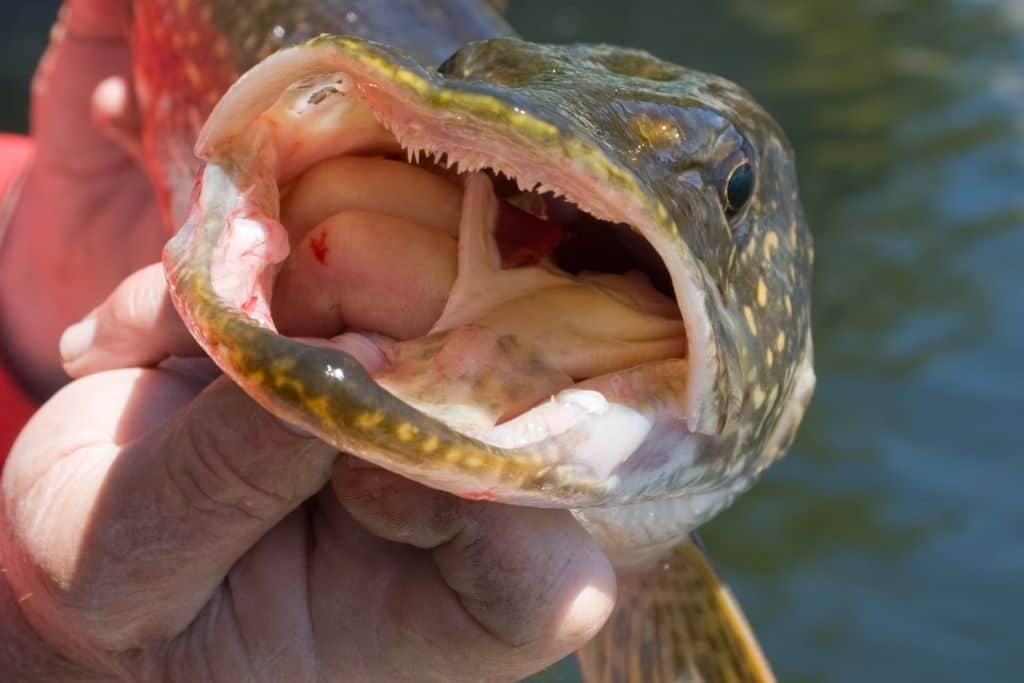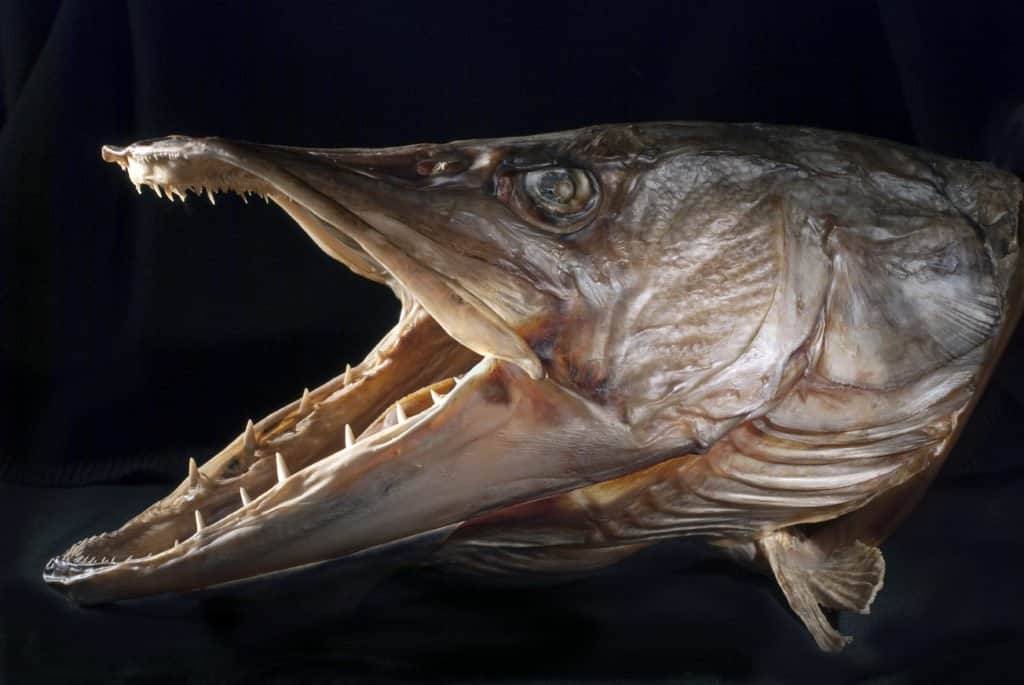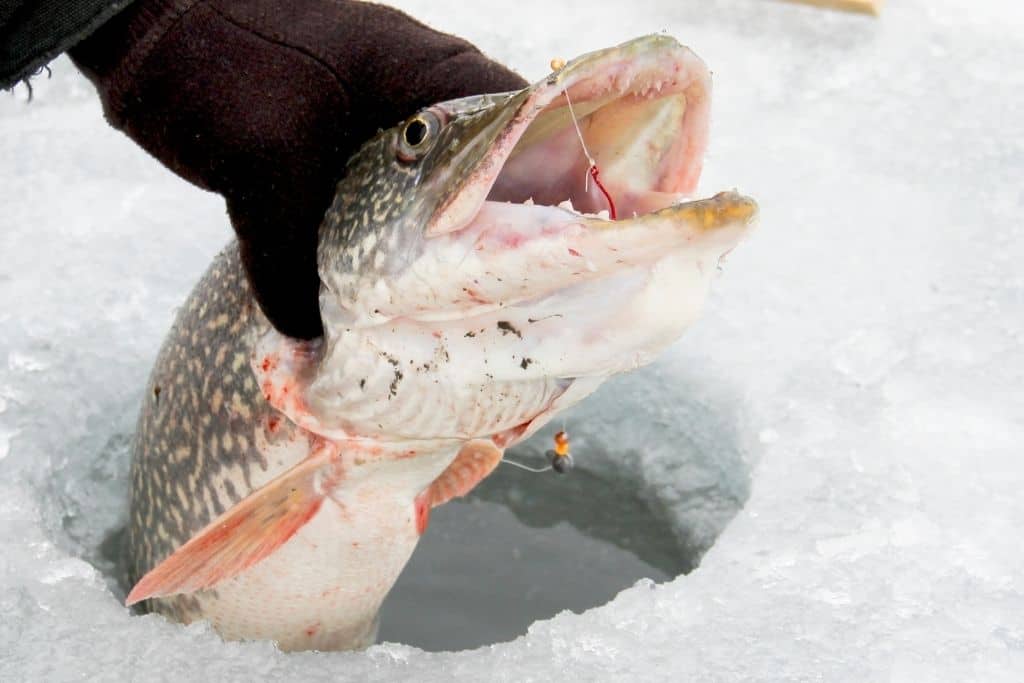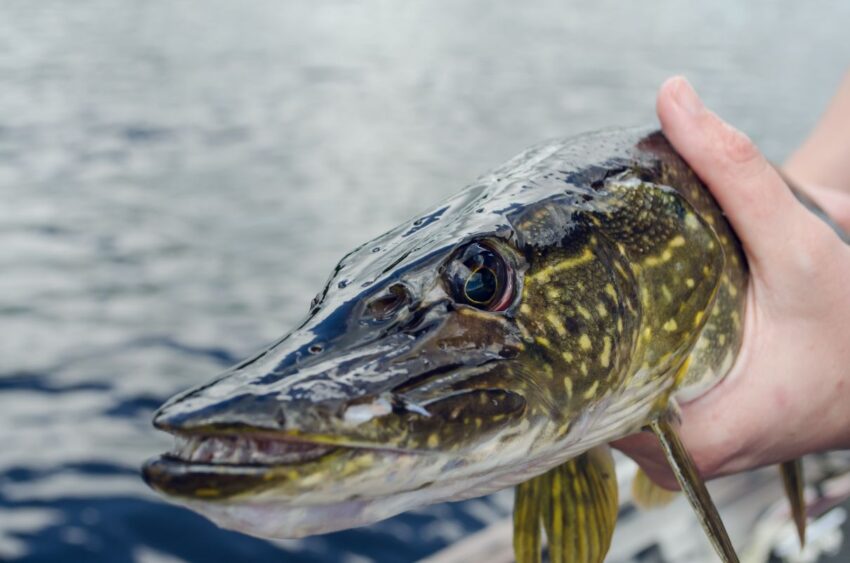The vicious predators known as the northern pike are typically at the top of the food chain. They chew through skin, feathers, and scales, but how do they do that?
The upper and lower jaws of the northern pike have multiple rows of between 300 and 700 needle-like teeth that can reach lengths of up to one inch (2.5 cm). These teeth are used to crush and dismember their prey.
We’ll talk about northern pike teeth in this article. Please keep reading.
Northern Pike Teeth Facts
Although the northern pike has an astonishing number of teeth, not all of them are equal. Fewer than most fish have the large, fang-like teeth that come to mind when thinking of this species, and the majority of their hundreds of teeth are found on the upper pad of their mouths.
The small, needle-like teeth point backward into their maw and ensure that any prey they catch will be unable to escape, while the large teeth aid in catching their prey.
How Many Teeth Does Northern Pike Have?
The majority of northern pike have between 300 and 500 teeth, including both the larger fang-like teeth and the smaller needle-pointed teeth. However, some outliers, such as the enormous pike carcass discovered in the United Kingdom, had as many as 700 teeth.
The smaller hooked teeth that latch onto their prey are typically between 0.2 and 0.4 inches or 0.5 and 1 centimeters in length, while the larger, more noticeable teeth can grow to be around one inch or 2.5 cm long.
The average northern pike grows to be between 24 and 30 inches long and 3 to 7 pounds in weight, but there are outliers at the top end of that range.
Most of the time, larger fish tend to be older, and although they consume almost anything smaller than themselves, other than humans, they have no natural predators.
Do Northern Pike Shed Their Teeth?
People who believe that pike does shed their teeth in the summer and those who reject that theory appear to be on opposite sides of the debate when it comes to this topic.
There is actually no proof to this day that Pike regularly lost their teeth, for example. like it’s also falsely believed that In August, walleyes spit out their teeth. It appears to be a fishing legend that has been circulating for years.

However, pike occasionally loses their teeth if they have been injured, such as when an attack goes wrong. The teeth in this situation may be damaged or broken off. If there is an infection beneath the teeth, pike may also lose their teeth.
Does Northern Pike Lose Their Teeth In The Summer?
It may be a sign that the waters in your area are not entirely healthy if there are local rumors that pike frequently loses their teeth in the summer, especially if there are high levels of bacteria in the water. Why?
Due to the fact that some waterborne bacteria can thrive in warm conditions, summer is a time of year when some bodies of water are more likely to breed pathogenic bacteria, which could lead to illness and tooth loss in some disgruntled pike.
The two most likely causes of pike losing teeth in summer:
- Pike lose teeth due to infection (normally caused by bacteria)
- Pike lose teeth due to pollution-related illness or infection
Outside of infection or illness, the only other likely causes would be:
- Extreme age causes some tooth loss in the largest pike nearing the end of its life cycle or
- Teeth that were damaged due to hitting really tough lures resulting in damaged teeth
There must be an external factor if there is significant pike tooth loss in a particular area. It’s not seasonal.
Does Northern Pike Lose Their Teeth In The Winter?
Since the summer has been pretty thoroughly debunked, if you were hoping that northern pike would lose their teeth in the winter, you’re about to be let down. Natural causes prevent northern pike from losing teeth during the winter.
Since pike tend to retreat to extremely deep water in the winter and it can be challenging to catch them using the most popular ice fishing lures, it is likely due to these factors that the story of pike losing teeth in the winter has gained so much traction.
There is a reason why pike being caught while ice fishing is so frequently reported: the pike swallowed the fish that had actually taken the bait.
Although pike doesn’t lose their teeth in the winter, it makes for a good angler story as to why they weren’t able to catch any that particular day.
In the video below, fast-forward to 8:20 and beyond to see a ton of big pike with lots of healthy teeth!
Why Do Northern Pike’s Teeth Lose?
Pike Lose Teeth Due To Sickness
A pike may lose teeth as a result of illness. This may be brought on by any of the many illnesses that fish in the area may contract, but it is frequently the result of an infection of some kind.

Sickness will be one of the most frequent causes of infections in pike, though the actual cause of infections that result in pike losing their teeth will vary depending on the region.
- Bacterial infection
- Infection via injury
- Infection/sickness from pollution
These will be the most frequent reasons for sick fish to be lost to northern pike.
Pike Lose Teeth Due To Damage
Because of damage, northern pike can lose teeth. This frequently occurs when they hit a hard lure, which causes their teeth to become chipped. These can be pushed out of the mouth in young, healthy pike, as well as those of average age, to make room for a new tooth.
The loss of a few teeth won’t have a significant impact on a northern pike’s lifespan, though, as it has 300–700 teeth in its mouth. There are more than enough tiny razor blades in the mouth to replace the one tiny missing tooth. Or even a few dozen.
Damage can account for the loss of a single tooth or several teeth.
Pike Lose Teeth Due To Age
Age-related tooth loss in pike is a possibility. This is not a natural occurrence or a seasonal occurrence. But this can also be caused by long-term injuries, muscle atrophy, or plain old age at the end of the life cycle.
Can Pike Bite Through Mono, Flouro, Or Braided line?
Yes to everything stated above. Using a leader when pike fishing is the only way to prevent northern pike from cutting through any type of line.
When fishing for pike, a lot of anglers use leaders made of monofilament, steel leaders like seven strands, or very thick fluorocarbon lines. The braided line is incredibly strong in terms of tensile strength, but the line is thin and when it comes to the shearing power of northern pike teeth, it can easily be frayed or your lures could be cut off entirely.
Northern Pike is incredibly accurate when it comes to catching prey because they have to be, but even they aren’t perfect precision fish-catching machines, and in many cases will misjudge the lead on a moving target and clamp down on your fishing line in front of the lure, this along with engulfing the entire lure up to the line is the reason why leaders are a requirement while pike fishing.
Do Pike Bite Humans?
There have been instances of humans getting the unfortunate northern pike bite. There are many videos on websites like YouTube that depict the unfortunate and painful encounters that take place, such as people dangling a dead prey fish in the water and the pike attacking the hand that is feeding them with their sharp teeth.
Sometimes these bits are to the hand and are caused by the ineptitude of the angler.
Other instances include pike biting swimmers in the foot or someone dangling and splashing their toes in the water off the side of a boat or dock while a pike zeroes in on splashing noises and movement that causes it to think the person is a snack and attacks it with its sharp teeth. These incidents do happen, but they are extremely uncommon in general.
Other than mistakenly mistaking a body part for small prey, pike does not specifically target humans and attack them. Northern pike has a brain the size of a pea and is honing in on peoples’ appendages out of a pure instinctual drive thinking they are wounded fish or other animals.
How To Safely Hold A Northern Pike?

To avoid the potential injury from a northern pike bite:
- Put on a pair of armored gloves that will not puncture, and hold them by the gills rather than the mouth.
- If you engage in catch and release, use your other hand to support their body weight and maintain them just above the surface.
- To safely remove the hook without running the risk of getting cut by their pointed teeth, use a hook-removing tool.
Final Thoughts
Fishing for pikes shouldn’t be discouraged by their teeth or the infrequent incident of one biting someone. When handled properly, there is very little chance that a pike’s mouth or teeth will hurt you.
If you’re considering traveling by car or plane to a remote area to catch your own northern pike, make sure you are ready for their quirks and keep this buying guide close at hand to make sure you have everything you need for your upcoming adventure!

